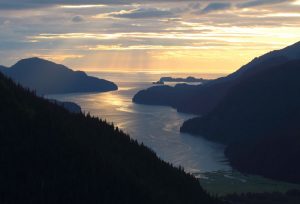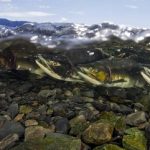Tag Archives: marine-mammal-protection-act

Harvesters charged with killing Stellar sea lions
A commercial fisherman and his deckhand have been charged with harassing and killing 15 Steller sea lions found dead during the opening of the 2015 Copper River salmon fishery. Jon Nichols, 31, of Cordova, captain of the F/V Iron Hide, and deckhand Theodore “Teddy” Turgeon, 21, of Wasilla, are charged with harassing and killing the Steller sea lions with shotguns and then making false statements and obstructing the government’s investigation into their criminal activities, the U.S. Attorney’s office in Anchorage said April 19. >click to read<09:14
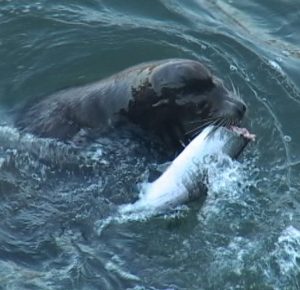
More seals, sea lions endangering orcas
Re: “Ottawa spending millions to help endangered orcas” and “Washington state moves to protect endangered southern residents,” March 16. These articles failed to address a couple of noteworthy things regarding prey availability for resident orcas, more resources for local salmon enhancement being one of them. The southern resident orcas are facing increased competition for salmon in large part due to the increase in harbour seal and California sea lion populations since the enactment of the Marine Mammal Protection Act in 1972. >click to read<17:00
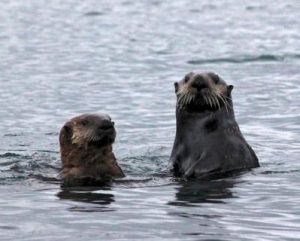
Sea otter resolution gets first hearing in Senate committee, asking Congress to amend the Marine Mammal Protection Act
A Senate committee Monday, March 12 heard from supporters and opponents of state involvement in the management of sea otters in Southeast Alaska. The Senate Resources committee held its first hearing on Senate joint resolution 13, which calls on the federal government to allow the state or a Native organization to co-manage the rebounding marine mammals and seek ways to increase harvest of otters. >click to read< 14:53
State seeks federal exemption to manage sea otters – The Legislature is considering two resolutions, one in the House and one in the Senate, asking Congress to amend the Marine Mammal Protection Act and,,, >click to read<

Petersburg assembly joins call for increased sea otter harvest
Petersburg Borough Assembly joined the call this month for measures to slow a growing population of sea otters in Southeast, as the marine mammals are impacting shellfish stocks. The Assembly passed a resolution at its March 5 meeting, calling for the federal government to work with the State of Alaska and Alaska Native tribes to establish strategies for an ecological balance of shellfish resources and the reintroduced sea otters. >click to read<08:23
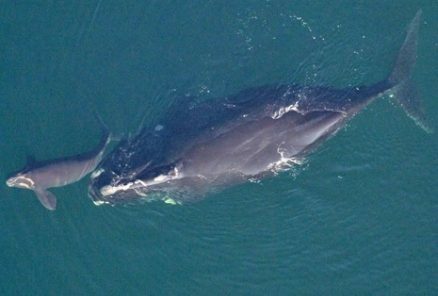
Gear is in wrong place for right whales, scientists say
Speaking at the Maine Fishermen’s Forum on Friday,,, The NOAA Fisheries Large Whale Take Reduction Team recently established separate working groups to study two proposals to reduce the risk of entanglement: splicing several 1,700-pound breaking strength “weak link” sleeves into vertical lines such as those that connect lobster buoys to traps; and removing those ropes altogether by requiring the use “ropeless” fishing gear. Those working groups will focus on whether either solution is technologically feasible, whether it will actually work for fishermen, and whether it can be cost effective for fishermen.,, >click to read<10:32

Stedman sponsors resolution to control sea otter growth
A Senate resolution seeking an increase in the number of sea otters hunted in Southeast Alaska is making its way through the legislative process. Sitka Republican Sen. Bert Stedman said the Senate Joint Resolution 13 is a way for the state to ask the federal government to do something about Southeast’s increasing otter population. “I think this is a good starting point for the conversation,” he said. “We live a different lifestyle up here, and we want to preserve it and keep it in balance. And having the sea otters virtually run unchecked,,, >click to read<19:30

Suit by animal protection groups follows deaths of 17 right whales in Canadian and U.S. waters last year
Conservation and animal-protection groups have sued the National Marine Fisheries Service in the United States, alleging it failed to protect right whales from entanglement in commercial fishing gear. The lawsuit, which was filed in federal court in Washington, D.C., late last week, alleges the federal management of the U.S. lobster fishery violates the Endangered Species Act and the Marine Mammal Protection Act. The lawsuit seeks to force the National Marine Fisheries Service to do a sufficient examination of the fishery’s impact on North Atlantic right whales and adopt additional measures to prevent entanglements. >click here to read< 18:55

Lawsuit filed to save North Atlantic Right Whales from death in fishing gear
Today’s lawsuit against the National Marine Fisheries Service, filed in federal court in Washington, D.C., alleges that federal management of the American lobster fishery violates the Endangered Species Act and the Marine Mammal Protection Act. The lawsuit seeks to force the agency to sufficiently examine the fishery’s impacts on North Atlantic right whales and adopt additional measures to prevent more entanglements in the future. The lobster fishery is the most active fixed-gear fishery in the northeastern United States. >click here to read< 12:08 
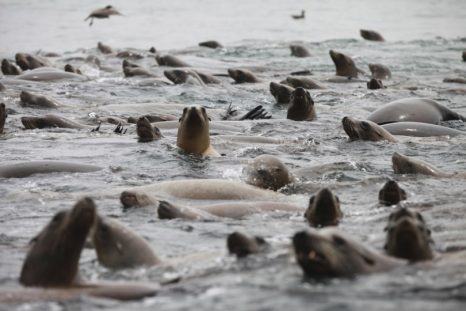
A quarter million?! California sea lion population has tripled, new study finds
The West Coast’s population of California sea lions — the playful marine animals that delight tourists on the Santa Cruz waterfront and San Francisco’s Fisherman’s Wharf while competing with salmon fishermen for valuable catches — has tripled in the past 40 years to more than 250,000.,,, But California sea lions — which range from Mexico to Alaska — have exploded the most in number, jumping from an estimated 88,924 in 1975 to 257,606 in 2014, according to the new NOAA study. But all the sea lions have caused problems. >click here to read<11:33
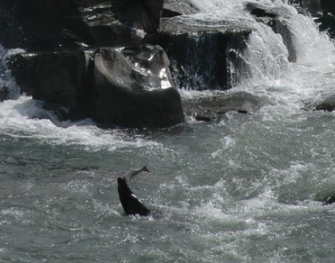
Dwindling winter steelhead are on their own again at Willamette Falls
With the first four dozen winter steelhead counted at Willamette Falls and scattered early catches reported in both the Clackamas and Sandy rivers, Oregon scientists, fish managers, anglers and others must helplessly hold their figurative breath. Sea lions, which chewed through as much as 25 percent of the dismal return of 2016-17 steelhead, pretty much have free rein this winter to repeat the carnage. “The impact, if left un-managed, will be pretty devastating,” said Shaun Clements, senior fish division policy advisor for the Oregon Department of Fish and Wildlife. click here to read the story 16:11
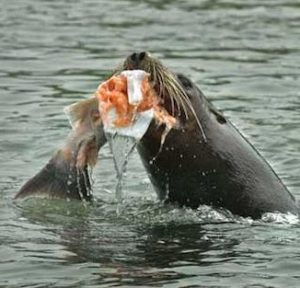
Endangered orcas compete with seals, sea lions for salmon
Harbor seals, sea lions and some fish-eating killer whales have been rebounding along the Northeast Pacific Ocean in recent decades. But that boom has come with a trade-off: They’re devouring more of the salmon prized by a unique but fragile population of endangered orcas. Competition with other marine mammals for the same food may be a bigger problem than fishing, at least in recent years, for southern resident killer whales that spend time in Washington state’s Puget Sound, a new study suggests. click here to read the story 07:43

NOAA/NMFS seeks input on proposed sea lion removal at Willamette Falls
NOAA Fisheries is seeking public input on an application from the Oregon Department of Fish and Wildlife (ODFW) to remove, by lethal means if necessary, California sea lions preying on endangered and threatened salmon and steelhead at Willamette Falls on the Willamette River near Oregon City. The approach would be similar to the ongoing removal of sea lions preying on vulnerable populations of protected fish at Bonneville Dam on the Columbia River. Under the Marine Mammal Protection Act (MMPA), each application NOAA Fisheries receives for removing problematic sea lions must undergo independent consideration. info, click here to read the story 08:36
Walruses adapt to loss of sea ice and are not endangered, feds say
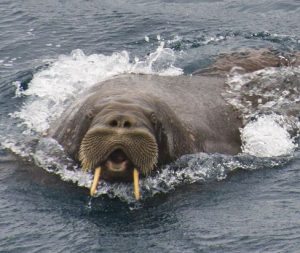 Blubbery, clam-loving Pacific walruses are surprisingly resilient to the dramatic loss of polar sea ice as the planet warms and won’t be listed as an endangered species, the federal government announced early Wednesday. The decision is controversial. A scientist for a group that works to protect endangered animals called it a Trump administration “death sentence for the walrus.” But Alaska Gov. Bill Walker, the state’s all-Republican congressional delegation, Native hunters, Arctic Slope Regional Corp. and the state Department of Fish and Game all said it was the right call. “This decision will allow for the continued responsible harvest of Pacific walrus for subsistence and traditional uses by Alaska Natives,” Sen. Lisa Murkowski said in a written statement. click here to read the story 21:11
Blubbery, clam-loving Pacific walruses are surprisingly resilient to the dramatic loss of polar sea ice as the planet warms and won’t be listed as an endangered species, the federal government announced early Wednesday. The decision is controversial. A scientist for a group that works to protect endangered animals called it a Trump administration “death sentence for the walrus.” But Alaska Gov. Bill Walker, the state’s all-Republican congressional delegation, Native hunters, Arctic Slope Regional Corp. and the state Department of Fish and Game all said it was the right call. “This decision will allow for the continued responsible harvest of Pacific walrus for subsistence and traditional uses by Alaska Natives,” Sen. Lisa Murkowski said in a written statement. click here to read the story 21:11
Enviro Groups Demand U.S., Canada Act to Save North Atlantic Right Whales
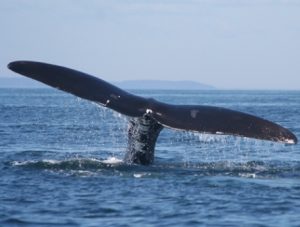 Conservation and animal-protection groups today sought action by the United States and Canada to prevent painful, deadly entanglements in fishing gear that threaten the critically endangered North Atlantic right whale. In letters to Canadian officials and the U.S. National Marine Fisheries Service, the groups demanded action to reduce risks to these imperiled whales. North Atlantic right whales, one of the world’s most endangered mammals with fewer than 500 individual animals remaining on Earth, lost nearly 3 percent of their population this year. click here to read the story 14:00
Conservation and animal-protection groups today sought action by the United States and Canada to prevent painful, deadly entanglements in fishing gear that threaten the critically endangered North Atlantic right whale. In letters to Canadian officials and the U.S. National Marine Fisheries Service, the groups demanded action to reduce risks to these imperiled whales. North Atlantic right whales, one of the world’s most endangered mammals with fewer than 500 individual animals remaining on Earth, lost nearly 3 percent of their population this year. click here to read the story 14:00
Oregon, Washington and tribes again take aim at sea lions in dispute over salmon
 Congress is once again considering giving Oregon and Washington fish and wildlife officials and regional tribes broader authority to kill sea lions below the Bonneville Dam, an effort supporters say is necessary to protect 13 endangered species of salmon and steelhead. But unlike previous attempts to rein in the marine mammals, which are protected under federal law, the legislation goes beyond killing the dozens that converge each spring on the fish logjam at the Columbia River dam 145 miles from the Pacific Ocean. The bipartisan team behind the bill — Reps. Jaime Herrera-Beutler, R-Washington, and Kurt Schrader, D-Oregon — want to go much further. They also want to make it easier to kill California sea lions found on the Willamette River and its tributaries, and anywhere on the Columbia River east of Interstate 205. If the legislation is approved, as many as 920 sea lions could be killed annually, compared with 92 under current law. click here to read the story 08:54
Congress is once again considering giving Oregon and Washington fish and wildlife officials and regional tribes broader authority to kill sea lions below the Bonneville Dam, an effort supporters say is necessary to protect 13 endangered species of salmon and steelhead. But unlike previous attempts to rein in the marine mammals, which are protected under federal law, the legislation goes beyond killing the dozens that converge each spring on the fish logjam at the Columbia River dam 145 miles from the Pacific Ocean. The bipartisan team behind the bill — Reps. Jaime Herrera-Beutler, R-Washington, and Kurt Schrader, D-Oregon — want to go much further. They also want to make it easier to kill California sea lions found on the Willamette River and its tributaries, and anywhere on the Columbia River east of Interstate 205. If the legislation is approved, as many as 920 sea lions could be killed annually, compared with 92 under current law. click here to read the story 08:54
Maine man gets three days in jail for shooting seal
 A Warren man pleaded guilty on Monday to shooting a seal off the coast of Acadia National Park last fall, according to federal prosecutors. Joseph A. Martin, 54, was sentenced to serve three days behind bars and was ordered by federal Magistrate Judge John C. Nivison to pay a $1,000 fine for shooting the animal, which is protected by the federal Marine Mammal Protection Act. Martin was acting as captain of a fishing boat on Oct. 10, 2016 when multiple seals approached the vessel, federal officials said Monday in a news release. Martin was fishing off the coast of Acadia National Park, which stretches from Schoodic Point to Isle Au Haut, officials said. click here to read the story 20:49
A Warren man pleaded guilty on Monday to shooting a seal off the coast of Acadia National Park last fall, according to federal prosecutors. Joseph A. Martin, 54, was sentenced to serve three days behind bars and was ordered by federal Magistrate Judge John C. Nivison to pay a $1,000 fine for shooting the animal, which is protected by the federal Marine Mammal Protection Act. Martin was acting as captain of a fishing boat on Oct. 10, 2016 when multiple seals approached the vessel, federal officials said Monday in a news release. Martin was fishing off the coast of Acadia National Park, which stretches from Schoodic Point to Isle Au Haut, officials said. click here to read the story 20:49
Gray seals are making a huge comeback on Cape Cod (where there are no longer any Cod!)
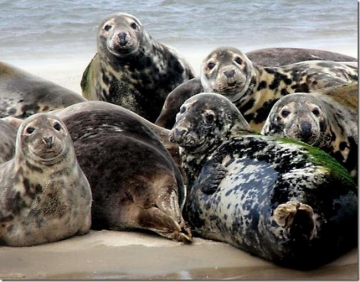 For nearly a hundred years, New England’s gray seals had a bounty on their heads. Maine and Massachusetts paid people to kill them, because they depleted fishing stocks. They were also hunted for their meat and pelts. By 1973—a year after the Marine Mammal Protection Act made it illegal to systematically kill the animals—a census estimated there were only 30 gray seals left along the entire coast of Maine. Since then, Canada’s gray seals have returned to recolonize the east coast of the U.S.,,, Now, in a study published in Bioscience, researchers have combined Google Earth images and data from tagged seals to make a more precise estimation of the population.,, “Our technology-aided aerial survey, which used Google Earth imagery in conjunction with telemetry data from tagged animals, suggests the number is much larger—between 30,000 and 50,000.” Not everyone is happy with the pinniped’s population explosion—particularly fisherman, who see them as competition for fish stocks. In recent years, some groups have advocated for culling the number of gray seals. Johnston says that not only would that be illegal, but it would also be premature. “We know almost nothing about what gray seals eat, how and where they forage,,, click here to read the story 10:48
For nearly a hundred years, New England’s gray seals had a bounty on their heads. Maine and Massachusetts paid people to kill them, because they depleted fishing stocks. They were also hunted for their meat and pelts. By 1973—a year after the Marine Mammal Protection Act made it illegal to systematically kill the animals—a census estimated there were only 30 gray seals left along the entire coast of Maine. Since then, Canada’s gray seals have returned to recolonize the east coast of the U.S.,,, Now, in a study published in Bioscience, researchers have combined Google Earth images and data from tagged seals to make a more precise estimation of the population.,, “Our technology-aided aerial survey, which used Google Earth imagery in conjunction with telemetry data from tagged animals, suggests the number is much larger—between 30,000 and 50,000.” Not everyone is happy with the pinniped’s population explosion—particularly fisherman, who see them as competition for fish stocks. In recent years, some groups have advocated for culling the number of gray seals. Johnston says that not only would that be illegal, but it would also be premature. “We know almost nothing about what gray seals eat, how and where they forage,,, click here to read the story 10:48
The “Redheaded Stepchild of Fishing” – Controversial drift-gill net fishery wins long-fought battle
 Federal fishery managers denied a proposal this week to immediately shut down Southern California’s most controversial fishery in the event that wide-mesh gill nets accidentally kill a handful of certain marine mammals or sea turtle species. The swordfish and thresher shark fishery will remain open, even if it kills several whales or sea turtles, the NOAA’s National Marine Fisheries decided. The decision not to institute so-called hard caps on the fishery comes after a public review period initiated last year was extended to discuss the law proposed by the state’s Pacific Fishery Management Council in 2014. For the few dozen fishers who still catch swordfish and thresher sharks off Southern California in deep-water drift gill nets, the decision brought a big sigh of relief. click here to read the story 08:38
Federal fishery managers denied a proposal this week to immediately shut down Southern California’s most controversial fishery in the event that wide-mesh gill nets accidentally kill a handful of certain marine mammals or sea turtle species. The swordfish and thresher shark fishery will remain open, even if it kills several whales or sea turtles, the NOAA’s National Marine Fisheries decided. The decision not to institute so-called hard caps on the fishery comes after a public review period initiated last year was extended to discuss the law proposed by the state’s Pacific Fishery Management Council in 2014. For the few dozen fishers who still catch swordfish and thresher sharks off Southern California in deep-water drift gill nets, the decision brought a big sigh of relief. click here to read the story 08:38
Bi-Partisan Bill seeks to allow tribes to kill Columbia River sea lions
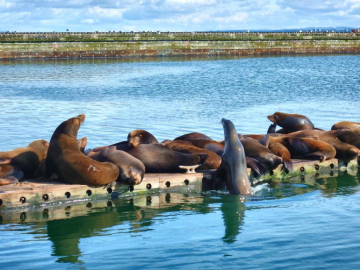 Some Northwest Indian tribes would be allowed to kill a limited number of sea lions that prey on endangered salmon in the Columbia River under a bill introduced in Congress. The bipartisan bill was introduced last weekend by U.S. House members Jaime Herrera Beutler, a Washington Republican, and Kurt Schrader, an Oregon Democrat. If passed, the bill would allow the Warm Springs, Umatilla, Yakama, and Nez Perce tribes to kill some sea lions that are decimating endangered salmon runs during their return from the ocean to inland spawning grounds. Currently only the states of Oregon, Washington and Idaho can kill sea lions along the river. “The spring chinook loss, coupled with the growing sea lion population, has placed us in an emergency situation,” said Leland Bill, chairman of the commission. Sea lion populations have surged since the passage of the Marine Mammal Protection Act in 1972. There were about 30,000 California sea lions when the act passed, but the population has since grown to over 300,000. click here to read the article 12:22
Some Northwest Indian tribes would be allowed to kill a limited number of sea lions that prey on endangered salmon in the Columbia River under a bill introduced in Congress. The bipartisan bill was introduced last weekend by U.S. House members Jaime Herrera Beutler, a Washington Republican, and Kurt Schrader, an Oregon Democrat. If passed, the bill would allow the Warm Springs, Umatilla, Yakama, and Nez Perce tribes to kill some sea lions that are decimating endangered salmon runs during their return from the ocean to inland spawning grounds. Currently only the states of Oregon, Washington and Idaho can kill sea lions along the river. “The spring chinook loss, coupled with the growing sea lion population, has placed us in an emergency situation,” said Leland Bill, chairman of the commission. Sea lion populations have surged since the passage of the Marine Mammal Protection Act in 1972. There were about 30,000 California sea lions when the act passed, but the population has since grown to over 300,000. click here to read the article 12:22
Video shows man attacking Hawaiian monk seal, culture expert mentions commercial fishermen?
 One of Kauai’s most popular Hawaiian monk seals was attacked on Tuesday night at Salt Pond Beach Park, and a video recording of the scuffle is circulating on social media. The footage shows an unidentified man enter the water at Salt Pond at sunset and attack RK30, a full-grown female monk seal, in what appears to be an attempt to chase the her from her resting place on the beach. Kumu Sabra Kauka, who teaches Hawaiian culture through education around the island, said she was disturbed when she saw the video. “That kind of behavior is uncalled for and is inexcusable,” she said. “Being high or drunk is no excuse. She said sometimes this kind of aggression toward the Hawaiian Monk Seals stems from the commercial fishing community and the mindset that the seals are stealing the fish from their nets. Read the article here Watch the video here 13:03
One of Kauai’s most popular Hawaiian monk seals was attacked on Tuesday night at Salt Pond Beach Park, and a video recording of the scuffle is circulating on social media. The footage shows an unidentified man enter the water at Salt Pond at sunset and attack RK30, a full-grown female monk seal, in what appears to be an attempt to chase the her from her resting place on the beach. Kumu Sabra Kauka, who teaches Hawaiian culture through education around the island, said she was disturbed when she saw the video. “That kind of behavior is uncalled for and is inexcusable,” she said. “Being high or drunk is no excuse. She said sometimes this kind of aggression toward the Hawaiian Monk Seals stems from the commercial fishing community and the mindset that the seals are stealing the fish from their nets. Read the article here Watch the video here 13:03
Cape Cod seals return in masses on video: Great whites and fishermen woes follow
 Before 1972 you were lucky to see a single seal in the waters or on the beaches of the Cape. Then when the Marine Mammal Protection Act went into effect, the hunting abruptly stopped and they were able to grow in number and that brings it up to the masses of seals being spotted today! They inhabited the beaches in masses until they were almost hunted to extinction along the Cape’s waters decades ago. Now that they are a protected species, their numbers are up, too far up for some folks who live and work on the Cape and surrounding areas. The fishermen who utilize these waters for their livelihood say that the seals are eating all the fish. The seals do eat a lot of fish. An 800-pound male seal “could consume up to six percent of his body weight each day. That’s 50 pounds of fish, including valuable species like cod and flounder.” With the seal population numbering in the thousands, you don’t have to do the math to see these summer residents are competition for the fishermen. Video, read the story here 10:56
Before 1972 you were lucky to see a single seal in the waters or on the beaches of the Cape. Then when the Marine Mammal Protection Act went into effect, the hunting abruptly stopped and they were able to grow in number and that brings it up to the masses of seals being spotted today! They inhabited the beaches in masses until they were almost hunted to extinction along the Cape’s waters decades ago. Now that they are a protected species, their numbers are up, too far up for some folks who live and work on the Cape and surrounding areas. The fishermen who utilize these waters for their livelihood say that the seals are eating all the fish. The seals do eat a lot of fish. An 800-pound male seal “could consume up to six percent of his body weight each day. That’s 50 pounds of fish, including valuable species like cod and flounder.” With the seal population numbering in the thousands, you don’t have to do the math to see these summer residents are competition for the fishermen. Video, read the story here 10:56
Court case highlights conflict between fishermen and marine mammals
 A Cape May County tuna fisherman is fighting federal charges of shooting a pilot whale that was feeding on his boat’s catch. Daniel Archibald denies the charges filed against him in U.S. District Court. But his lawyer, Bill Hughes Jr., said in court papers that even if Archibald shot the animal, he wasn’t breaking any laws. The unusual case highlights the often contentious relationship between fishermen and the seals, whales and dolphins that steal their catch. And it points to the murky laws that give fishermen, marine contractors, researchers and others permission,,, Read the rest here 14:15
A Cape May County tuna fisherman is fighting federal charges of shooting a pilot whale that was feeding on his boat’s catch. Daniel Archibald denies the charges filed against him in U.S. District Court. But his lawyer, Bill Hughes Jr., said in court papers that even if Archibald shot the animal, he wasn’t breaking any laws. The unusual case highlights the often contentious relationship between fishermen and the seals, whales and dolphins that steal their catch. And it points to the murky laws that give fishermen, marine contractors, researchers and others permission,,, Read the rest here 14:15
NOAA recognizes Predator/Prey Relationship of exploding populations of Marine Mammal Populations and fish!
 The study by scientists from NOAA Northwest Fisheries Science Center and the University of Washington examines recovering predator populations along the West Coast of the United States and in the Greater Yellowstone ecosystem, and the conflicts surrounding them. The study was published today in the journal Conservation Letters. In the Pacific Northwest, for example, California sea lions that have increased under the Marine Mammal Protection Act have increasingly preyed on endangered salmon.,, Read the rest here 16:01
The study by scientists from NOAA Northwest Fisheries Science Center and the University of Washington examines recovering predator populations along the West Coast of the United States and in the Greater Yellowstone ecosystem, and the conflicts surrounding them. The study was published today in the journal Conservation Letters. In the Pacific Northwest, for example, California sea lions that have increased under the Marine Mammal Protection Act have increasingly preyed on endangered salmon.,, Read the rest here 16:01
Congress Proposes Relaxing Sea Lion Protections
 The Endangered Salmon and Fisheries Predation Prevention Act, a proposed amendment to the federal Marine Mammal Protection Act, could soon give tribal members and government fishery managers in the Columbia River Basin authority to kill sea lions threatening endangered salmon populations. U.S. Reps Jaime Herrera Beutler (R-WA) and Kurt Schrader (D-OR) introduced the amendment on January 27. Read the rest here 08:41
The Endangered Salmon and Fisheries Predation Prevention Act, a proposed amendment to the federal Marine Mammal Protection Act, could soon give tribal members and government fishery managers in the Columbia River Basin authority to kill sea lions threatening endangered salmon populations. U.S. Reps Jaime Herrera Beutler (R-WA) and Kurt Schrader (D-OR) introduced the amendment on January 27. Read the rest here 08:41
Voracious protected seals starting to overrun waters off New England
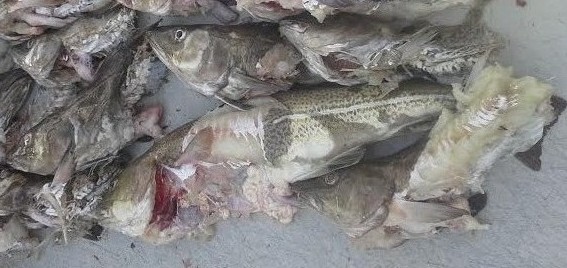 But what is the cost? Nils Stolpe, a Florida-based fishing industry journalist and advocate, calculated that since each seal consumed 5 percent of its body weight each day in squid, mollusks, crustaceans, and a variety of fish including rockfish, herring, flounder, salmon, hake, and lance, and don’t forget cod, it amounts to q a quarter million pounds daily. Annually he added it up to 450,000 million pounds, about 200,000 metric tons. Read the rest here 07:07 Read Dogfish and seals and dolphin, oh my! by Nils Stolpe here
But what is the cost? Nils Stolpe, a Florida-based fishing industry journalist and advocate, calculated that since each seal consumed 5 percent of its body weight each day in squid, mollusks, crustaceans, and a variety of fish including rockfish, herring, flounder, salmon, hake, and lance, and don’t forget cod, it amounts to q a quarter million pounds daily. Annually he added it up to 450,000 million pounds, about 200,000 metric tons. Read the rest here 07:07 Read Dogfish and seals and dolphin, oh my! by Nils Stolpe here
Murkowski roundly criticizes NOAA proposed ringed seal habitat
 National Oceanic and Atmospheric Administration plans to designate much of Alaska’s northern coastline as critical habitat for ringed seals have led the state’s senior U.S. senator to blast the proposal’s “Texas-sized” area. NOAA Out of Control, “NOAA’s justification admits several non-scientific reasons motivated its decision, Read the rest here 20:47
National Oceanic and Atmospheric Administration plans to designate much of Alaska’s northern coastline as critical habitat for ringed seals have led the state’s senior U.S. senator to blast the proposal’s “Texas-sized” area. NOAA Out of Control, “NOAA’s justification admits several non-scientific reasons motivated its decision, Read the rest here 20:47
Federal double standard on endangered species laws?
The federal government is not shy about prosecuting those who violate threatened and endangered species laws. But under a new Obama administration policy, wind farm operators are getting 30-year permits to kill protected species. Read more here 11:48
Alaska joins Hawaii to have central North Pacific humpbacks struck from endangered list
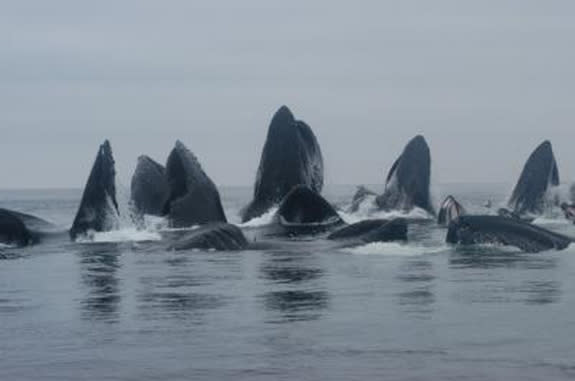
Alabama man admits shooting dolphin in Mississippi Sound
GULFPORT — A commercial boat captain from Bayou La Batre, Ala., has pleaded guilty to shooting a dolphin with a shotgun in the Mississippi Sound in the summer of 2012. Brent Buchanan faces maximum penalties of one year in prison and a $100,000 fine at his sentencing on Feb. 24. more@sunherald 09:55







 People in Marina del Rey, Calif., were surprised when a sea lion pup wandered into their apartment complex. But getting help for Walter when he was spotted last week wasn’t easy. Nearly 1,000 have washed ashore so far this year. The warmer water could have affected the availability of prey to the sea lions. Another possibility is “the sea lion population is reaching carrying capacity.
People in Marina del Rey, Calif., were surprised when a sea lion pup wandered into their apartment complex. But getting help for Walter when he was spotted last week wasn’t easy. Nearly 1,000 have washed ashore so far this year. The warmer water could have affected the availability of prey to the sea lions. Another possibility is “the sea lion population is reaching carrying capacity. 































